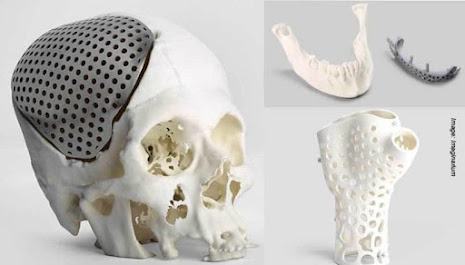3D Printing Technology
3D printing, also known as additive manufacturing, is a technique for layering a three-dimensional object using a computer-generated design. Subtractive manufacturing procedures, in which a final design is cut from a larger block of material, are the polar opposite of additive manufacturing. As a result, there is less waste from 3D printing. 3D printing is also suitable for rapid prototyping.
Thermoplastics, such as acrylonitrile butadiene styrene
(ABS), metals (including powders), resins, and ceramics are among the materials
used in 3D printing.
Hideo Kodama of the Nagoya Municipal
Industrial Research Institute invented the first 3D printing manufacturing
equipment when he invented two additive processes for generating 3D models.
Hideo Kodama's early work in Laser
Cured Resin Rapid Prototyping was finished in 1981,
building on Ralf Baker's work in the 1920s for creating decorative objects
(patent US423647A). With the launch of stereolithography in 1984, his
innovation was further developed over the next three decades. In 1987, 3D
Systems' Chuck Hull invented the first 3D printer, which employed the
stereolithography method. The development of selective laser sintering and
selective laser melting, among other things, followed. Other 3D printing
systems were developed in the 1990s and 2000s, but their prices decreased
drastically after the patents expired in 2009, allowing more people to access
the technology.
3D Printing Technologies
Sintering, melting, and stereolithography are the three main
types of 3D printing technique.
•
Sintering is a technique for creating high-resolution products
in which the material is heated but not to the point of melting. For direct
metal laser sintering, metal powder is utilised, while thermoplastic powders
are used for selective laser sintering.
•
Powder bed fusion, electron beam melting, and direct energy
deposition are 3D printing melting processes that use lasers, electric arcs, or
electron beams to melt materials together at high temperatures to print
objects.
•
Photopolymerization is used in stereolithography to manufacture
parts. This technology uses the right light source to selectively interact with
the material, curing and solidifying a cross section of the product in thin
layers.
Types of 3D printing
3D printing can be classified into one of the
following categories:
•
VAT Polymerization
•
Binder Jetting
•
Direct Energy Deposition
•
Material Extrusion
•
Material Jetting
•
Powder Bed Fusion
•
Sheet Lamination
Advantages and Disadvantages
The advantages of
3D printing include:
•
Easy development of unique geometric parts with no extra cost:
This technology enables for the easy creation of bespoke geometric components
with no further expense. Because 3D printing uses no extra material, it can be
cheaper than subtractive manufacturing.
•
Cheap start-up costs: Since no moulds are required, these
production expenses are low. Material, labour, and post-processing time all
contribute to the cost of a part.
•
Due to the use of computer-aided designs (CAD), any product
modifications are simple and do not affect manufacturing costs.
•
Perfect for rapid prototyping as the technology enables small
batches and in-house production, it is ideal for rapid prototyping.
•
Creates parts with specific properties: While plastics and
metals are the most popular materials used in 3D printing, other materials can
be used to create parts with specific features. For specialised purposes, parts
can be made with increased heat resistance, water resistance, or strength.
The disadvantages of
3D printing include:
•
Less strength than traditional manufacturing: While some parts,
like metal, have outstanding mechanical qualities, many other 3D printed items
are more brittle. Because the parts are created layer by layer, the strength is
reduced by 10% to 50%.
•
High volume production is more expensive with 3D printing. For
quantities above 100 units, 3D printing is estimated to be less cost effective
than CNC machining or injection moulding, assuming the parts can be made
conventionally.
•
Accuracy limitations: It depends on the machine and/or process
employed. Because some desktop printers have tighter tolerances than others,
the finished pieces may be slightly different. While this can be rectified in
post-processing, 3D printed items are not always perfect.
•
The majority of 3D printed parts require some type of
post-processing to produce a desired finish, removal of support struts, heat
treatment to achieve specified material qualities, or final machining.
3D Printing Industries
Due to its versatility, 3D printing is used in
many industries, including:
Aerospace
Its inherent weight and cost reductions have
endeared it to the automobile industry. It is a
quick prototyping tool for testing or small-scale manufacturing. If a
part is no longer available, it can be made as a part of a limited batch,
containing spare parts. Alternatives include overnight printing of goods or
fixtures for testing before a larger production run.
3D printing is being used in medicine to
create custom implants and gadgets. Hearing aids, for example, may be made
swiftly from a digital file matched to a body scan. This reduces costs and
production times.
Want to know more about MIT College of Railway Engineering and Research Barshi, MH.






Insightful
ReplyDeleteinformative
ReplyDelete